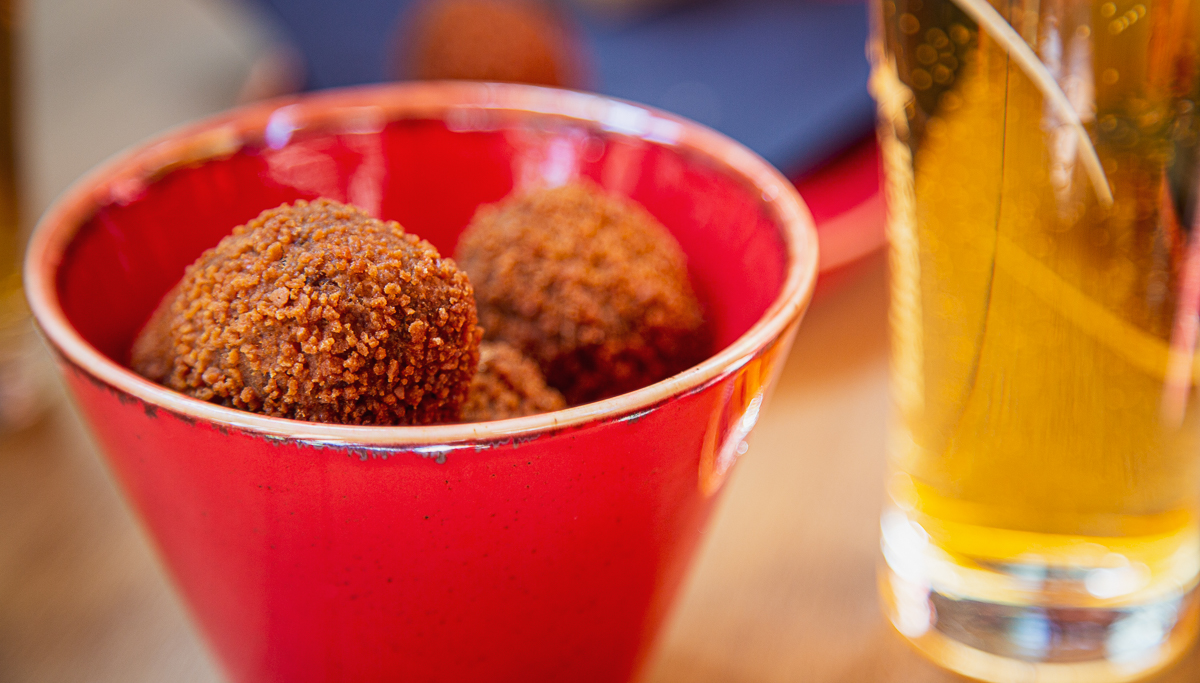Treats and snacks
The Dutch love to snack. We have many snack bars and café’s to settle in for a bite to eat. You do get hungry fast when you cycle everywhere right? These snacks and treats are to enjoy on the go but sitting down at one of the ‘terrasjes’ (large outside seating area’s from café’s or restaurants) with a local beer like Heineken or Amstel is very satisfying.
Stroopwafels
The ‘stroopwafel’ (syrup waffle/ caramel waffle) is one of the most known Dutch treats originating in Gouda (yes, the city of Gouda Cheese). They are made up of thin waffles cut in two layers with a caramelly syrup between them. The best way to eat these luscious treats are warm and fresh from a waffle stand on a Dutch market like the ‘Albert Kuyp Markt’ in Amsterdam, also readily available at markets throughout the Netherlands. We have never heard anyone dislike the stroopwaffel, so this is a must try when you’re in the country. Another variety of this treat is the ‘stroopkoek’, this one is more cookie-like but a little less pleasing in our opinion.
Bitterballen
What can we say? This is THE snack to get the party started! These little two-bite deep fried balls are found at almost every party, conference or pub in the country and very well accompanied with some mustard and a ‘fluitje’ (small glass of lager beer). Bitterballen are a mixture of small cut meat in a thick stew, with a breaded outside and deep fat fried to create a crispy layer. It took Tom a while to get used to the thought, taste and texture of the bitterballen but after about three tries he was sold! Every time we set foot on Dutch soil, the first thing we do is go to a pub or restaurant to get a beer and bitterballen.
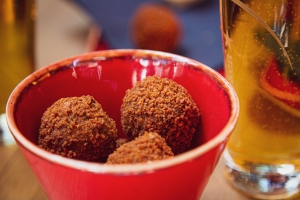
Kroketten
Kroketten are actually just big bitterballen, the bigger the better right? They are often eaten for lunch with a soft roll to make a ‘broodje kroket’ or two slices of bread. Add some mustard and mayonnaise and you’re ready to go! The ‘kroket’ and ‘broodje kroket’ are widely available in the FEBO, this is a walk-up fastfood restaurant founded in Amsterdam in 1941. The FEBO is known for their vending machines where you can get your take away ‘kroket’ and other snacks. So next time you’re in Amsterdam go ‘kroketje trekken’ (pull a kroket) in one of the many vending machines of the FEBO, or try it as a fancy lunch in any restaurant.
Bittergarnituur
One last snack out of the deep fat fryer you need to try is ‘bittergarnituur’. This platter is a mixture of the best fried snacks you will ever try. This platter can exist out of various snacks like bitterballen (ofcourse), mini frikandellen (meat rolls), mini kaassoufflé (breaded puff-pastry filled with cheese), nasi bal (breaded spiced rice balls), bami schijf (breaded spiced noodle-like balls) and mini loempia’s (small Vietnamese fried vegetable spring rolls). You will find the locals digging into this snack feast at most restaurants watching the world go by.
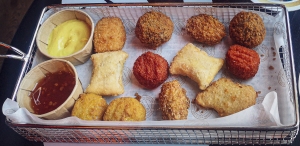
Poffertjes
Poffertjes are small fluffy, pancake-like bites served warm with lots of powdered sugar and butter. They are available throughout the year and made fresh in a poffertjes stand on any market. They can also be garnished with chocolate, whipped cream, strawberries or advocaat (thick alcoholic beverage).
Bossche bol
This calorie bomb is a gift straight out of heaven! The Bossche bol originating from ‘s-Hertogenbosch (also Den Bosch) is a whipped cream filled, chocolate coated, round piece of pastry much like a large profiterole. The one and only place to get the best Bossche bol in the world will be the confectionary of Jan de Groot in ‘s-Hertogenbosch, which has the secret recipe and is known as the ‘real’ Bossche bol. Be prepared for a cue for the café but it is so worth it!
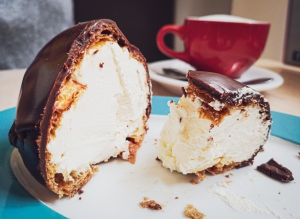
Tompouce
The ‘tompouce’ is a traditional treat that is slowly disappearing. It is a treat that is mostly served at birthdays or other celebrations. The tompouce is a rectangular pastry with a bottom layer of puff-pastry, a second layer of a custard and whipped cream mixture, with again a layer of puff-pastry and topped with a pink sugary glaze. The most known tompoezen (plural) are bought from the HEMA, a shop that sells just about everything, from school supplies to home accessories and groceries.
Eating a tompouce is quite the challenge. It will be messy and no one actually knows how to do it. Most Dutch will put it on a plate with a pastry fork, but when you cut into the hard top layer the filling will squeeze out the other side. Some take off the top layer and take this in one hand, then take the bottom part in the other hand and take sequential bites of both parts. You will find yourself trying to be decent starting off with the fork, but you will most likely end with both your hands covered in glaze and custard. We warned you!
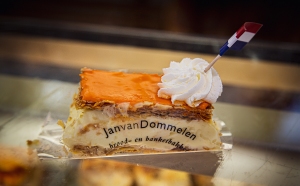
Drop
Drop is one of the most avoided treats by tourists. We definitely get why, Tom does not even want to smell them… Drop is a small black salty or sweet hard liquorish treat. They are available in many shapes and sizes like coins, cats or beehives. They are sold in supermarkets and almost every ‘markt’ (street market) throughout the Netherlands. I, Mandy, am a Dutch national born and raised and don´t even like most of the drop, only the sweet honey kind. So, scared to try? Start off with the sweeter ones 😊
Brabantse worstenbroodjes
‘Worstenbroodjes’ are small firm sausage rolls which are very loved especially in the south of the Netherlands. Again, these are very common snacks at a family gathering or house party. The sausage rolls tend to be quite salty but this varies from bakery to bakery. If you’re in the South, try them from bakery Wieggers in Breda and spend the day in this lovely city!

Warme chocolademelk / Hot chocolate
Who doesn’t love a hot chocolate? I am sure nearly everyone on the planet has tried a variation of the hot chocolate. But not with fresh slagroom / whipped cream! Have we convinced you to try now?

Breakfast
Honestly, the Dutch do not have lovely breakfast traditions like a full English breakfast or an elegant French croissant. The modesty of the natives once again reflects on their habits, making breakfast as simple as a sandwich or two with a cup of black coffee. Nonetheless these ‘simple’ sandwiches can be very delightful. The Netherlands is known for its tasteful bread. We do tend to spend that little more to get a nice fresh loaf from the local bakery. So, next time waking up in this humble county, try a ‘boterham’ (slice of bread) with one of the following toppings:
Kaas (cheese)
Cheese, who would’ve guessed?! We Dutchies love cheese, and that is why we often eat a cheese sandwich to start the day well. Two slices of fresh bread from the bakery with a little butter and a fair amount of good cheese. My favourite is Old Amsterdam cheese, with its strong salty taste it really goes well in a sandwich with lettuce and cucumber. Other known cheeses are Gouda or Leerdammer cheese which are also widely available outside of the Dutch borders.
Hagelslag
Many of you will find this weird but for the Dutch it is as normal as the cheese sandwich: chocolate sprinkles on bread! This bizarre topping is loved by all and can be found in any home (especially with kids).
Appelstroop
Spreads like peanut butter and chocolate spread are very popular in the Netherlands but the old generation is more accustomed to ‘appelstroop’ (apple butter/syrup). This thick spread is sweet and sticky and is made of a concentrated sauce of apples and cider. The syrup is a good source of iron but there is still a fair amount of sugar in it, so eat it because it is tasty, not for possible health benefits.
Bread with strawberries
This one is not as popular as some of the other breakfast options but nonetheless very tasteful. A good way of starting your busy summer day will be with a slice of white bread laced with slices of strawberries. The real sweet-tooth’s among us will want to add a little extra sugar to make it extra sweet. Keep in mind that it’s not as healthy as the strawberries might suggest.
Yoghurt with granola or porridge
If you don’t want to eat bread in the morning there are also lighter options for breakfast. It is very common to eat some yoghurt with granola or ‘havermout pap’ (oatmeal porridge). Add some fresh fruits like apple or raspberries and you have a nutritious meal ready to go.
Dinner
If you are a tourist in the Netherlands it might be hard to find a ‘real’ local dish on your restaurant menu. Most elderly and rural-living natives will still have the tradition of the ‘AVG-rule’ which stands for ‘aardappelen, vlees en groenten’ (potatoes, meat and vegetables). This will likely be a plain boiled vegetable like the broccoli with a meatball and boiled potatoes. The younger generation are a bit bored of these traditional meals and cook more foreign dishes like pasta’s, curries and wok dishes. The Dutch are quite early eaters, usually sitting at the table for 6 pm.
Stamppot
The most Dutch meal ever is stamppot. It is a dish usually eaten on the cold winter days. ´Stamppot´ is a collective name for many different types existing of mashed potatoes with mashed cabbage, endive, sauerkraut or carrots. Usually served with a type of meat like traditional ´rookworst´ (smoked sausage) or bacon strips.
Pannenkoeken in a pannenkoekenhuis
´Pannenkoeken´, a Dutch pancake is often eaten as a treat. We love to eat them with various sweet and savoury toppings like powdered sugar, stroop (syrup), bacon, cheese and apple. The list is never ending. In the Netherlands you can find many restaurants dedicated to pancakes. One of our favourite restaurants ‘Theehuis Rhijnauwen’ serves the finest pancake ever tasted. Their ‘spek’ (bacon) and ‘Kaas’ (cheese) pancake is to die for, which we add additional ‘stroop’ (syrup) to mix savoury with sweet. The restaurant is located in Amelisweerd. Here you can spend some time walking in the woods or alongside the river with the ability to hire a canoe and paddle to the canals of Utrecht city centre! Read all about it in ´The best pancake house in The Netherlands´.
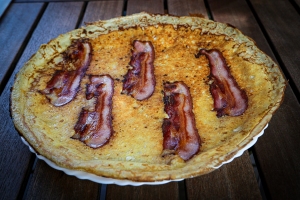
Erwtensoep
‘Erwtensoup’ is a pea soup that is very thick and filled with pork, onion, leek, carrots and ‘rookworst’ (smoked sausage). As well as the stamppot, this dish is usually eaten in the winter. Most families will serve the soup with slices of ‘roggebrood’ (rye bread) with cheese or cooked and smoked bacon.
Nasi or Bami Goreng
Due to the colonial history of the Netherlands we tend to eat lots of Indonesian dishes like ‘nasi’ and ‘bami goreng’. These dishes consist of fried rice or bami (can be compared with noodles) with vegetables and lots of herbs. The dish can be eaten with small cut meat like chicken, beef or pork but is just as delicious without. Add a fried or scrambled egg, some crispy fried onions and some prawn crackers and the meal is complete. (Ps. If you like this you might want to try the nasi and bami snacks from the deep fat fryer)
Kapsalon
The ‘kapsalon’ is not an old tradition but actually a new dish created in 2003. The word ‘kapsalon’ translates as ‘hairdressers salon’. Don’t let the translation put you off, the invention came from a hairdresser from Rotterdam. The kapsalon is often eaten as a late night snack after a party. In a metal take-away tray you will have french fries with cooked dönner meat (lamb is the best). Add some cheese and grill in the oven until melted. Next, you add some lettuce and other salad toppings (red onion, tomato and cucumber) and generously pour over some garlic and ‘sambal’ sauce. Sambal is a hot sauce originating from Indonesia and very loved by the Dutch.
This dish is great after a night of partying. Therefore, you don’t have to feel guilty by the amount of calories. The dish has now become famous in other countries with added meat variations.
Get in touch with us if you have tried any of the above Dutch foods/snacks and share with us your stories. We would love to hear how your Dutch experience was received @contact us.
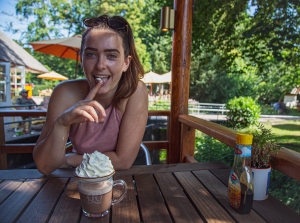
Mandy, Travelling Translated
This blog might contain affiliate links. This means if you click on it and buy something, we’ll possibly make a small commission from it, at no additional cost to you. This enables us to keep sharing our travel tips and stories for you to enjoy.

